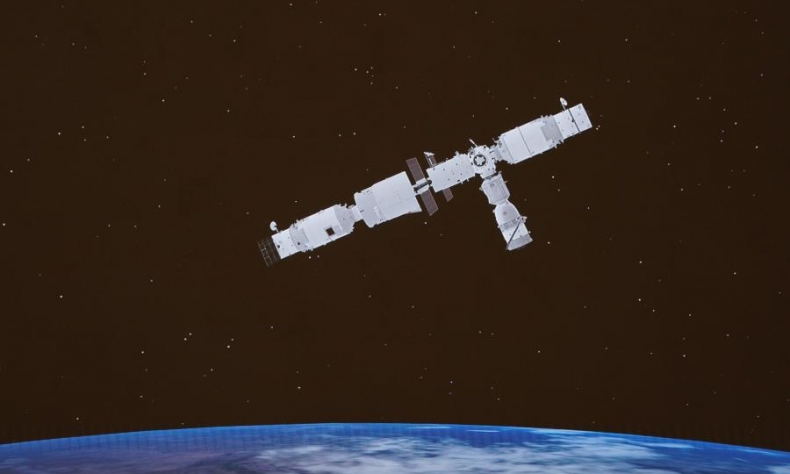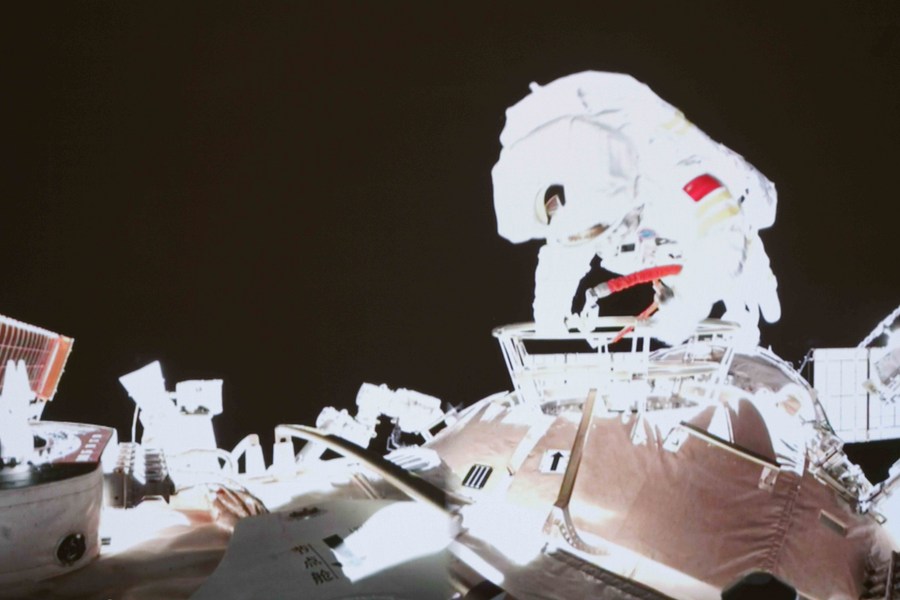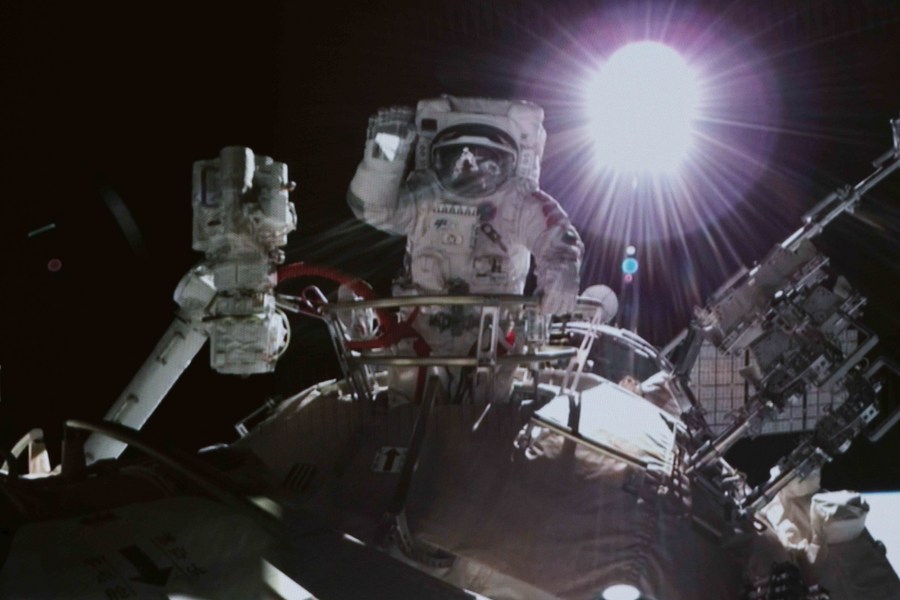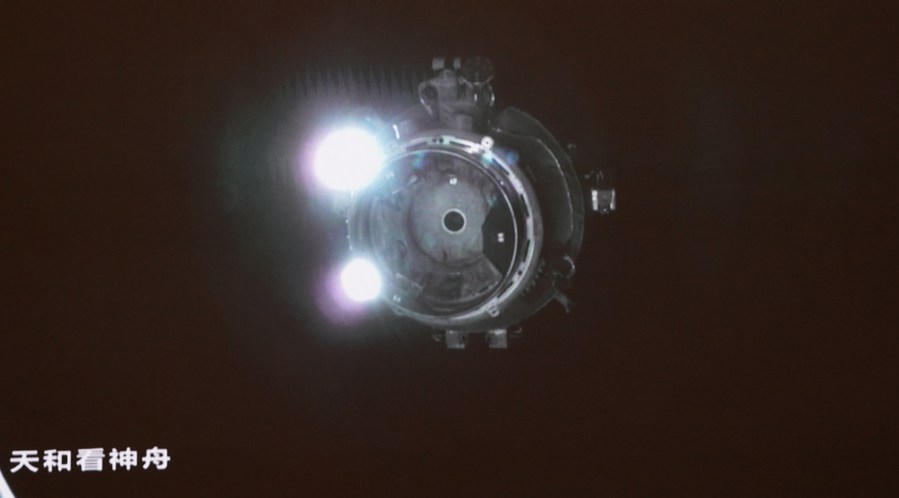Construction of China’s Space Station Is in Full Swing

Over 10 flight missions have been scheduled for the two-year construction period of Tiangong, including the launch of the core module and the two lab capsules, plus four manned spaceships and four unmanned cargo crafts.
Wang Yaping became China’s first female spacewalker on November 7, when she took part in the Shenzhou-13 mission’s first extravehicular activities (EVAs), alongside mission commander Zhai Zhigang. The event was the third extravehicular mission conducted during the construction of the country’s space station Tiangong, or Heavenly Palace.
The Shenzhou-13 spaceship was launched on October 16, sending three astronauts on a six-month in-orbit mission to construct the space station.
The pair returned to the core module after 6.5 hours of EVAs. They performed a series of extravehicular tasks, including installing a dual-arm connector and a suspension device, which will both be used to connect the big arm to the core module Tianhe, or Harmony of Heaven, and the small arm to the lab module Wentian, which is expected to be launched and docked with Tianhe in 2022.
The connected mechanical arms will be able to transfer a heavier load across a larger distance. The arms can cover three modules of the space station to inspect their surface at any time and carry out other difficult and diverse missions, said Gao Sheng, an engineer in charge of the mechanical arm operation with the China Academy of Space Technology.
Born in a village in Yantai, a coastal city in Shandong Province, in 1980, Wang had a knack for sports from childhood onward. After finishing high school in 1997, she was recruited as a pilot. In 2010, she was selected as one of China’s second group of astronauts.
In June 2013, Wang took part in the Shenzhou-10 mission, which lasted nearly 15 days, during which she gave China’s first space-based lecture to Chinese students from inside the Tiangong I experimental module.

Space chores
The Shenzhou-13 crew are scheduled to carry out two to three EVAs during their six-month stay in space and plan to conduct more scientific experiments than their Shenzhou-12 counterparts, who had spent three months in the space station until their return to Earth in mid-September.
Wang and her colleagues will carry out research in aerospace medicine and microgravity physics. In addition to the experiments, they will also remotely control the docking of a spacecraft with the space station.
“We also want to conduct more science popularization activities to enable the public to take a closer look at space and our life inside the space station, and feel the magic and beauty of space,” Wang said in an interview with China Central Television (CCTV) before embarking on the journey.
The three astronauts have also carried out their first in-orbit emergency evacuation exercise. The exercise simulated a situation where the core module loses pressure after being hit by space debris and the astronauts need to retreat to the return capsule of the Shenzhou-13 spacecraft.
The space environment is complex and dangerous and one of the major threats facing the space station is a collision with debris. The aim of the exercise was to ensure the astronauts can safely evacuate after such a clash. During the drill, the astronauts, as per required, stabilized pressure within the core module, checked for leaks, and evacuated to the return capsule.
The exercise took several minutes and was supported by ground control. Wang Chunhui, deputy chief trainer of Chinese astronauts, told CCTV there is a set of well-planned procedures to analyze and handle emergencies such as pressure loss or fire.

A big mission
China is a latecomer to space station construction. The Soviet Union launched Salyut-1, the world’s first space station, in 1971. Since then, over 10 space stations have been launched, most of which by the Soviet Union.
Before Tiangong, the only operational station in orbit was the International Space Station (ISS), a joint effort by several national space agencies including the United States’ National Aeronautics and Space Administration and Russia’s Roscosmos. However, China has been excluded from the project mainly because of U.S. objections.
The ISS was completed in 2011 and is reportedly set to retire by the end of the decade, which will likely leave Tiangong as the only operational station until the next station is put into orbit.
Tiangong is built under a three-step strategy for China’s manned space program approved in 1992 by the country’s central leadership. The first step was to launch a manned spacecraft and carry out space experiments. The second was to carry out EVAs, the docking of the spacecraft and the launch of space labs. The third was to build the space station.
After the successful implementation of previous tasks and breakthroughs in key technologies, China has entered the third stage of its space program. On April 29, the core module of the Tianhe space station was launched from the Wenchang Space Launch Center in Hainan Province.
The Tiangong space station will be constructed in the shape of a T, with the core module at the center and two lab capsules at the top on either side. The core module has two berth ports for the two lab capsules, and three docking ports for spacecraft delivering cargo and crew. It also has an exit through which astronauts can conduct EVAs.

Although Tiangong was launched much later than the previous space stations such as the ISS, it features several unique advantages, employing many cutting-edge technologies and materials.
For instance, it uses an electric propulsion engine, which can produce propulsion without combustion of fuel. It transforms solar energy into electricity which is then transformed into mechanical power. As it no longer needs liquid or solid fuel, its structure is less complex, reducing the station’s weight and fuel requirements.
The 10-meter-long robotic arm installed on Tianhe can manipulate objects weighing as much as 25 tons. It can move flexibly like a human arm and transport cargo around the outside of the space station, including supporting EVAs as well as the installation, maintenance and replacement of equipment.
Over 10 flight missions have been scheduled for the two-year construction period of Tiangong, including the launch of the core module and the two lab capsules, plus four manned spaceships and four unmanned cargo crafts. The station will complete construction and go into operation in 2022, with a designed life of no less than 10 years, which can be extended to 15 years through regular maintenance.
To support the construction and operation of the station, 18 new astronauts-17 men and one woman-were selected in October 2020. They include seven spacecraft pilots, seven space flight engineers and four mission payload specialists, according to the China Manned Space Agency. The space flight engineers and mission payload specialists are the first to be chosen under China’s space program.
China is also willing to open its space station to other nations. Since 2016, China has solicited cooperative experimental programs from all UN member countries and has thus far picked out nine programs from 17 countries.
 Facebook
Facebook
 Twitter
Twitter
 Linkedin
Linkedin
 Google +
Google +










